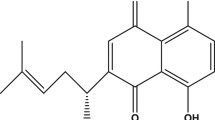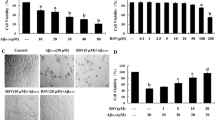Abstract
Oxidative stress and cytotoxic damage induced by amyloid beta (Aβ) have been considered pivotal in the pathogenesis of Alzheimer’s disease (AD) and may represent a target for treatment. The phosphatidylinositol 3-kinase (PI3K)/Akt pathway elicits a survival signal to protect against multiple injuries, and the transcription factor nuclear factor erythroid 2-related factor 2 (Nrf2), a downstream target of the PI3K/Akt pathway, can bind to HO-1. Resveratrol, a natural polyphenol derived from grapes, has been widely reported to have diverse antioxidative effects against AD, but the mechanisms have not been fully elucidated. The present study aims to investigate the effects of resveratrol on Aβ1–42-induced cytotoxicity in PC12 cells and to explore the potential mechanisms of these effects. PC12 cells were cultured and treated with Aβ1–42. Oxidative stress was assessed by measuring malondialdehyde (MDA), glutathione (GSH), and superoxide dismutase (SOD) levels. After treating with resveratrol at different concentrations (0, 10, 20, 40 μM) and for different durations (24, 48, 72 h), the generation of MDA, GSH, and SOD were detected; cell viability was assessed by MTT assay. The production of reactive oxygen species (ROS) was determined using an ROS Assay Kit. Western blotting was used to detect the protein expression. Our studies showed that pretreatment with resveratrol could reduce Aβ1–42-induced oxidative stress in PC12 cells by inhibiting the generation of MDA and ROS and increasing the production of SOD and GSH. Resveratrol markedly attenuated the Aβ1–42-induced loss in cell viability in PC12 cells in both a dose- and time-dependent manner. More importantly, resveratrol stimulated the activation of HO-1, Nrf2, PI3K, and phosphorylated Akt. Notably, the neuroprotective effects of resveratrol were eliminated by the HO-1 inhibitor zinc protoporphyrin IX (ZnPP), Nrf2 small interfering RNA (siRNA), and the PI3K/Akt inhibitor LY294002. Taken together, the findings suggest that the cytoprotection of resveratrol against the cytotoxicity induced by Aβ1–42 in PC12 cells is through the upregulation of HO-1 expression via the activation of the PI3K/AKT/Nrf2 intracellular signaling pathway, which might provide novel insights for understanding the mechanism of the neuroprotective effect of resveratrol as an anti-AD drug.






Similar content being viewed by others
References
Pan PK, Qiao LY, Wen XN (2016) Safranal prevent rotenone-induced oxidative stress and apoptosis in an in vitro model of Parkinson’s disease through regulating Keap/Nrf2 signaling pathway. Cell Mol Biol (Noisy-le-grand) 62(14):11–17
Machiela E, Dues DJ, Senchuk MM, Van Raamsdonk JM (2016) Oxidative stress is increased in C. elegans models of Huntington’s disease but does not contribute to polyglutamine toxicity phenotypes. Neurobiol Dis 96:1–11
Garcia-Blanco A, Baquero M, Vento M, Gil E, Bataller L, Chafer-Pericas C (2017) Potential oxidative stress biomarkers of mild cognifive impairment due to Alzheimer’s disease. J Neurol Sci 373:295–302
Gupta A, Lacoste B, Pistell PJ, Ingram DK, Hamel E, Alaoui-Jamali MA, Szarek WA, Vlahakis JZ, Jie S, Song W, Schipper HM (2014) Neurotherapeutic effects of novel HO-1 inhibitor in vitro and in a transgenic mouse model of Alzheimer’s disease. J Neurochem 131(6):778–790
Wang ZY, Liu JG, Li H, Yang HM (2016) Pharmacological effects of active components of Chinese Herbal Medicine in the treatment of Alzheimer’s disease: a review. Am J Chin Med 44(8):1525–1541
Huang FC, Kuo HC, Huang YH, Yu HR, Li SC, Kuo HC (2017) Ant-inflammatory effect of resvertrol in human coronary arterial endothelial cells via induction of autophagy: implication for the treatment of Kawasaki disease. BMC Pharmacol Toxicol 18(1):3
Duan GL, Wang CN, Liu YJ, Yu Q, Tang XL, Ni X, Zhu XY (2016) Resvertrol alleviates endotoxemia-associated adrenal insufficiency by suppressing oxidative/nitrative stress. Endocr J 63(6):569–580
Zhai XX, Ding JC, Tang ZM (2015) Resvertrol inhibits proliferation and induces apoptosis of pathological scar fibroblasts through the mechanism involving TGF-beta1/Smads signaling pathway. Cell Biochem Biophys 71(3):1267–1272
Liu Y, Zhou J, Qu Y, Yang X, Shi G, Wang X, Hong Y, Drlica K, Zhao X (2016) Resvertrol antagonizes antimicrobial lethality and stimulates recovery of bacterial mutants. PLoS ONE 11(4):e0153023
Chen P, Wang B, Pan B, Guo W (2016) Resveratrol-4-O-D-(2′-galloyl)-glucopyranoside exerts an anticaner effect on leukemia cells via inducing apoptosis. Mol Med Rep 13(3):2281–2286
Dhooghe B, Bouckaet C, Capron A, Wallemacq P, Leal T, Noel S (2015) Resvertrol increases F508del-CFTR dependent salivary secretion in cystic fibrosis mice. Biol Open 4(7):929–936
Whitehouse S, Chen PL, Greenshields AL, Nightingale M, Hoskin DW, Bedard K (2016) Resveratrol, piperine and apigenin differ in their NADPH-oxidase inhibitory and reactive oxygen species-scavenging properties. Phytomedicine 23(12):1494–1503
Shen C, Cheng W, Yu P, Wang L, Zhou L, Zeng L, Yang Q (2016) Resveratrol pretreatment attenuates injury and promotes proliferation aof neural stem cells following oxygen-glucose deprivation/reoxygenation by upregulating the expression of Nrf2, HO-1 and NQO1 in vitro. Mol Med Rep 14(4):3646–3654
Liu XQ, Wu BJ, Pan WH, Zhang XM, Liu JH, Chen MM, Chao FP, Chao HM (2013) Resveratrol mitigates rat retinal ischemic injury: the roles of matrix metalloproteinase-9, inducible nitric oxide, and heme oxygenase-1. J Ocul Pharmacol Ther 29(1):33–40
Huang TC, Lu KT, Wo YY, Wu YJ, Yang YL (2011) Resveratrol protects rats from Abeta-induced neurotoxicity by the reduction of iNOS expression and lipid peroxidation. PLoS ONE 6(12):e29102
Vivanco I, Sawyers CL (2002) The phosphatidylinositol 3-kinase AKT pathway in human cancer. Nat Rev Cancer 2:489–501
Ishii T, Itoh K, Takahashi S, Sato H, Yanagawa T, Katoh Y, Bannai S, Yamamoto M (2000) Transcription factor Nrf2 coordinately regulates a group of oxidative stress-inducible genes in macrophages.. J Biol Chem 275:16023–16029
Lei Y, Yang L, Ye CY, Qin MY, Yang HY, Jiang HL, Tang XC, Zhang HY (2015) Involvement of intracellular and mitochondrial Abeta in the ameliorative effects of Huperzine A against Oligomeric Abeta42-induced injury in primary rat neurons. PLoS ONE 10(5):e0128266
Fong S, Teo E, Ng LF, Chen CB, Lakshmanan LN, Tsoi SY, Moore PK, Inoue T, Halliwell B, Gruber J (2016) Energy crisis precedes global metabolic failure in a novel Caenorhabditis elegans Alzheimer disease model. Sci Rep 6:33781
Braidy N, Jugder BE, Poljak A, Jayasena T, Mansour H, Nabavi SM, Sachdev P, Grant R (2016) Resveratrol as a potential therapeutic candidate for the treatment and management of Alzheimer’s disease. Curr Top Med Chem 16(17):1951–1960
He X, Li Z, Rizak JD, Wu S, Wang Z, He R, Su M, Qin D, Wang J, Hu X (2017) Resveratrol attenuates formaldyhyde induced hyperphosphorylation of Tau protein and cytotoxicity in N2a cells. Front Neurosci 10:598
Luo L, Sun Z, Zhang L, Li X, Dong Y, Liu TC (2013) Effects of low-level laser therapy on ROS homeostasis and expression of IGF-1 and TGF-beta1 in skeletal muscle during the repair process. Lasers Med Sci 28(3):725–734
Wu N, Shen H, Liu H, Wang Y, Bai Y, Han P (2016) Acute blood glucose fluctuation enhances rat aorta endothelial cell apoptosis, oxidative stress and pro-inflammatory cytokine expression in vivo. Cardiovas Diabetol 15(1):109
Xipell E, Gonzalez-Huarriz M, Martinez de Irujo JJ, Garcia-Garzon A, Lang FF, Jiang H, Fueyo J, Gomez-Manzano C, Alonso MM (2016) Salinomycin induced ROS results in abortive autophagy and leads to regulated necrosis in glioblastoma. Oncotarget 7(21):30626–30641
Opii WO, Joshi G, Head E, Milgram NW, Muggenburg BA, Klein JB (2008) Proteomic identification of brain proteins in the canine model of human aging following a long-term treatment with antioxidants and a program of behavioral enrichment: relevance to Alzheimer’s disease. Neurobiol Aging 29:51–70
Nguyen T, Yang CS, Pickett CB (2004) The pathways and molecular mechanisms regulating Nrf2 activation in response to chemical stress. Free Radic Biol Med 37:433–441
Calkins MJ, Johnson DA, Townsend JA, Vargas MR, Dowell JA, Williamson TP (2009) The Nrf2/ARE pathway as a potential therapeutic target in neurodegenerative disease. Antioxi Redox Signal 11:497–509
Li MH, Jang JH, Na HK, Cha YN, Surh YJ (2007) Carbon monoxide produced by heme oxygenase-1 in response to nitrosative stress induces expression of glutamatecysteine ligase in PC12 cells via activation of phosphatidylinositol 3-kinase and Nrf2 signaling. J Biol Chem 282:28577–28586
Lee YJ, Im JH, Lee DM, Park JS, Won SY, Cho MK, Nam HS, Lee YJ, Lee SH (2012) Synergistic inhibition of mesothelioma cell growth by the combination of clofarabine and resveratrol involves Nrf2 downregualtion. BMB Rep 45(11):647–652
Huang WY, Chao XJ, Ouyang Y, Liu AM, He XX, Chen MH, Wang LH, Liu J, Yu SW, Rapposelli S, Pi RB (2012) Tacrine-6-ferulic acid, a novel multifunctional dimer agianst Alzheiemr’s disease, prevents oxidative stress-induced neuronal death through activating Nrf/ARE/HO-1 pathway in HT22 cells. CNS Neurosci Ther 18(11):950–951
Kwon KJ, Kim JN, Kim MK, Lee J, Ignarro LJ, Kim HJ, Shin CY, Han SH (2011) Melatonin sygergistically increases resveratrol-induced heme oxygenase-1 experssion through the inhibition of ubiquitin-dependent proteasome pathway: a possible role in neuroprotection. J Pineal Res 50(2):110–123
Acknowledgements
This work was supported by the research projects of the Chongqing Municipal Health Bureau (CSTC: 2008-2-381).
Author information
Authors and Affiliations
Corresponding author
Rights and permissions
About this article
Cite this article
Hui, Y., Chengyong, T., Cheng, L. et al. Resveratrol Attenuates the Cytotoxicity Induced by Amyloid-β1–42 in PC12 Cells by Upregulating Heme Oxygenase-1 via the PI3K/Akt/Nrf2 Pathway. Neurochem Res 43, 297–305 (2018). https://doi.org/10.1007/s11064-017-2421-7
Received:
Revised:
Accepted:
Published:
Issue Date:
DOI: https://doi.org/10.1007/s11064-017-2421-7




